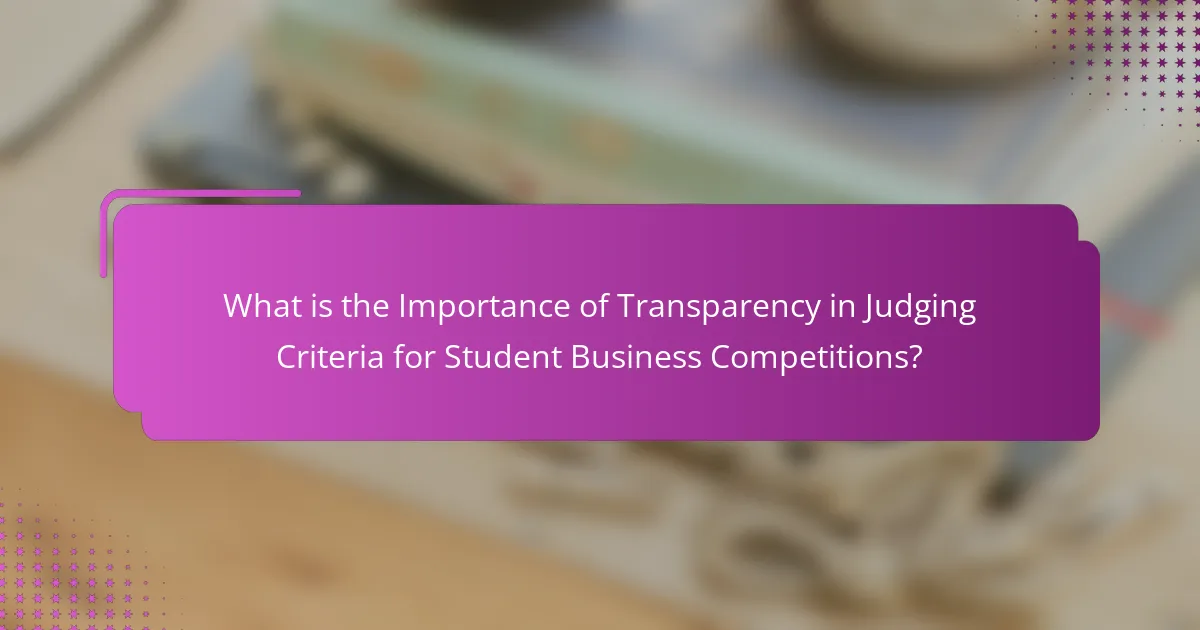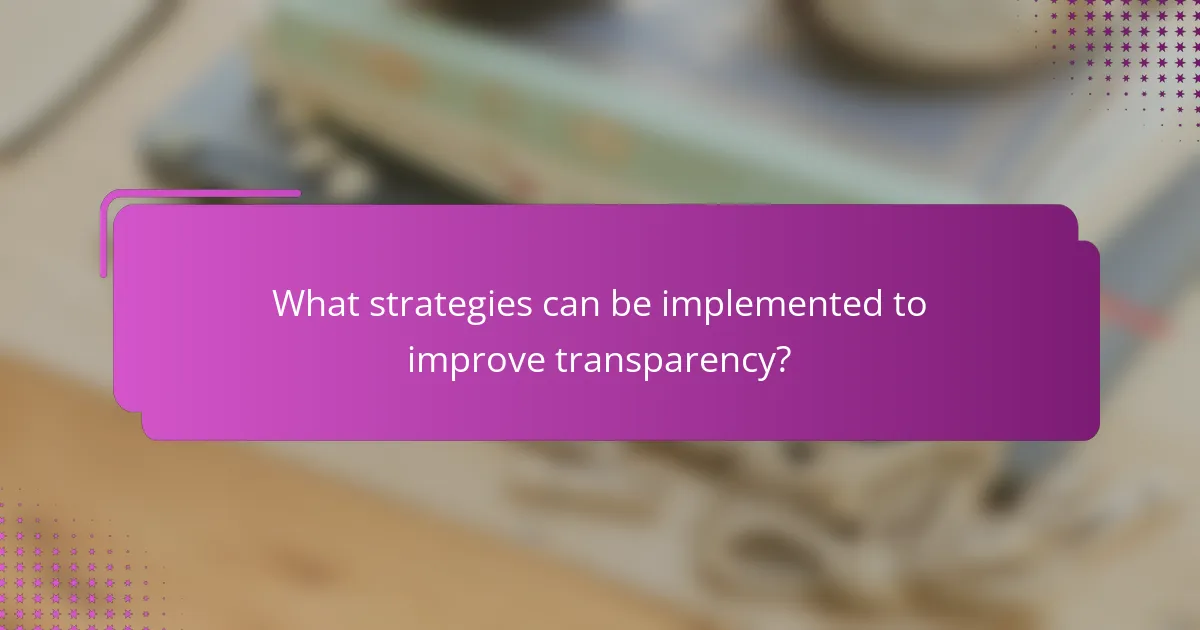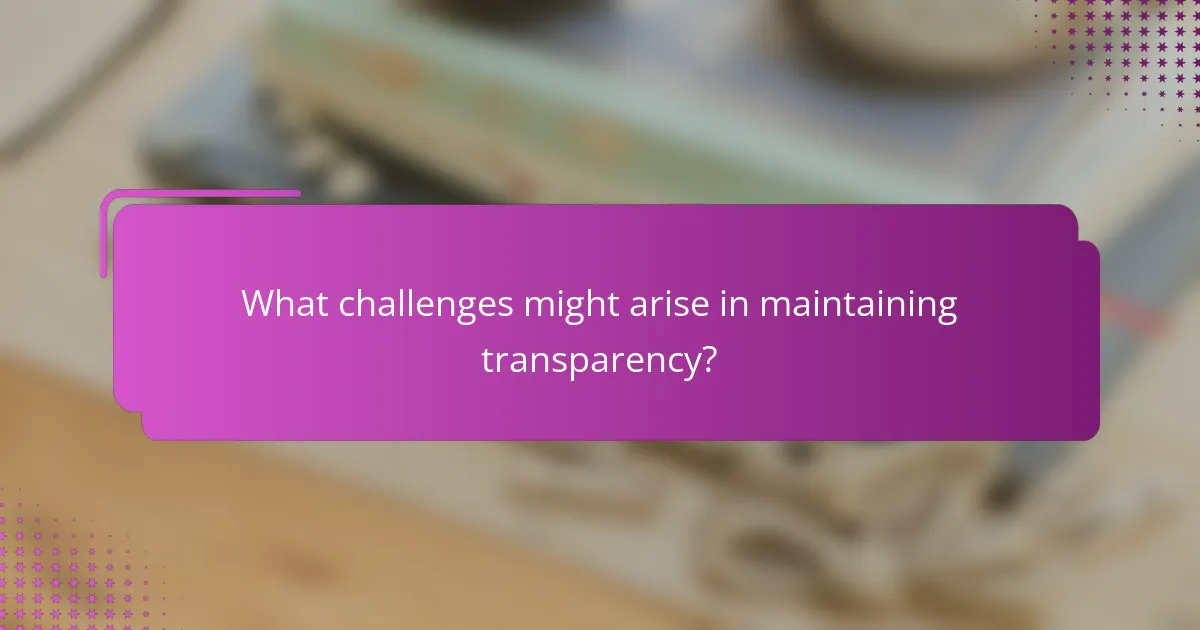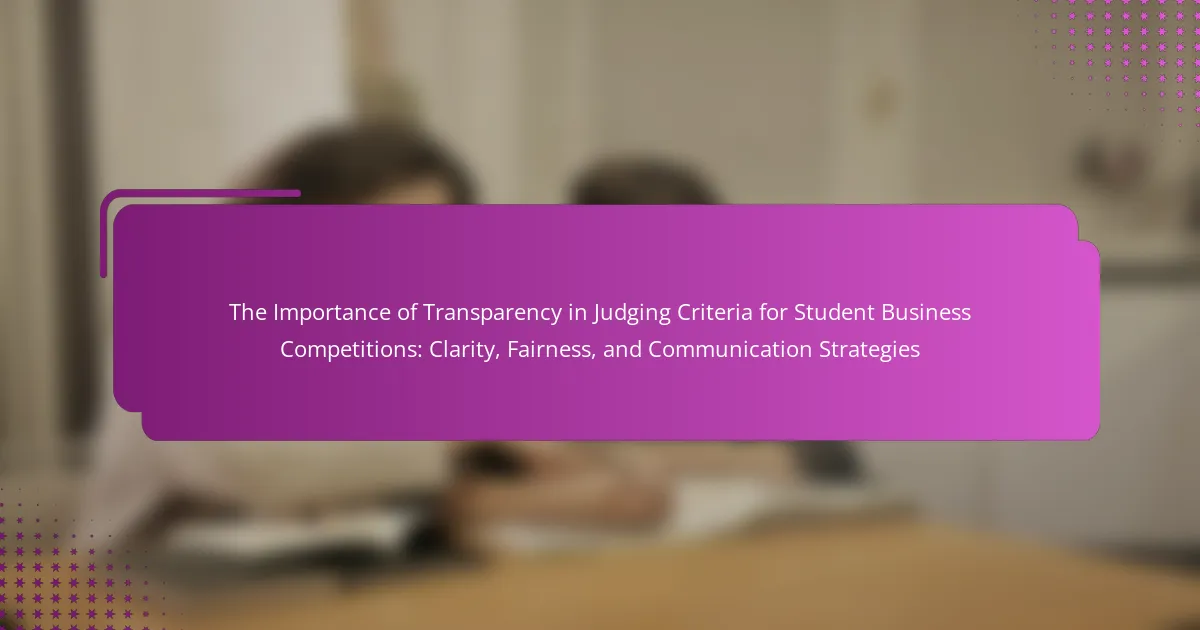Transparency in judging criteria is essential for student business competitions as it ensures fairness and clarity in the evaluation process. Clear criteria enable participants to understand evaluation metrics, fostering trust between competitors and judges while enhancing the overall quality of submissions. Effective communication strategies, such as providing detailed guidelines, accessible resources, and regular updates, are crucial for maintaining transparency. However, challenges such as miscommunication, lack of standardized criteria, and potential biases can undermine this transparency. Addressing these issues is vital for promoting integrity and fairness in competition judging.

What is the Importance of Transparency in Judging Criteria for Student Business Competitions?
Transparency in judging criteria for student business competitions is crucial for ensuring fairness. Clear criteria help participants understand how their submissions will be evaluated. This understanding fosters trust among competitors and judges. Transparency reduces ambiguity in the evaluation process. It allows participants to align their efforts with the expectations set forth. Furthermore, clear criteria can enhance the overall quality of submissions. When participants know the standards, they are more likely to meet or exceed them. Research shows that competitions with transparent judging criteria report higher satisfaction levels among participants. This satisfaction can lead to increased participation in future events.
Why is transparency crucial in judging criteria?
Transparency is crucial in judging criteria because it ensures fairness and accountability in the evaluation process. Clear criteria allow participants to understand how their submissions will be assessed. This understanding promotes trust among competitors, as they feel confident that all entries are judged equally. Transparency also reduces the potential for bias, as it establishes a standardized framework for evaluation. Furthermore, when judges provide detailed feedback based on transparent criteria, it enhances the learning experience for participants. Studies show that competitions with clear judging criteria report higher satisfaction rates among participants. For example, a survey by the National Association of Business Competitions found that 85% of students valued transparency in judging as essential for a fair competition.
What are the key elements of transparent judging criteria?
Key elements of transparent judging criteria include clarity, fairness, consistency, and accessibility. Clarity ensures that criteria are clearly defined and understandable. Fairness guarantees that all participants are judged based on the same standards. Consistency requires that judges apply criteria uniformly across all submissions. Accessibility means that criteria are available to all participants, allowing them to prepare effectively. Research shows that transparent criteria enhance trust and engagement in competitions, leading to better participant experiences.
How does transparency impact the perception of fairness?
Transparency enhances the perception of fairness by providing clear information about processes and decisions. When participants understand the criteria and reasoning behind judgments, they feel more included. This understanding fosters trust in the decision-makers. Research shows that transparent practices reduce perceptions of bias. A study by B. S. Cohn et al. found that transparency in evaluation processes led to higher satisfaction among participants. Clear communication of criteria also minimizes misunderstandings. Consequently, transparency serves as a vital mechanism for ensuring fairness in competitive environments.
How does transparency contribute to clarity in judging?
Transparency enhances clarity in judging by providing clear criteria and processes. When judges disclose their evaluation methods, participants understand how decisions are made. This understanding reduces confusion and promotes trust in the judging process. Transparency also allows participants to align their efforts with the criteria. Clear communication of expectations leads to better performance. Studies show that transparent judging improves participant satisfaction and perceived fairness. For instance, a survey in educational competitions found that 85% of participants felt more confident when criteria were clearly communicated. Thus, transparency is essential for clarity in judging.
What role does clear communication play in judging criteria?
Clear communication is essential in judging criteria as it ensures all participants understand the evaluation process. It helps eliminate ambiguity regarding expectations and standards. When criteria are communicated clearly, judges can apply them consistently. This consistency fosters fairness in evaluations. Moreover, clear communication allows participants to align their presentations with the judging standards. Research indicates that transparent criteria lead to higher participant satisfaction in competitions. A study by McKinsey & Company found that clear communication improves performance outcomes in competitive settings. Thus, clear communication significantly enhances the integrity and effectiveness of judging criteria.
How can judges ensure clarity in their evaluations?
Judges can ensure clarity in their evaluations by using standardized criteria. This approach provides a consistent framework for assessment. Clear criteria help judges communicate expectations effectively. Judges should also provide specific feedback for each evaluation. This feedback clarifies strengths and areas for improvement. Regular training on evaluation methods enhances judges’ consistency. Judges can utilize scoring rubrics to quantify their assessments. Research shows that transparent criteria improve participant understanding and satisfaction.
What are the implications of transparency on student engagement?
Transparency in judging criteria significantly enhances student engagement. It fosters trust between students and judges. When students understand the evaluation process, they feel more included. Clear criteria motivate students to perform better. Research shows that transparency leads to higher satisfaction rates among participants. A study by McKinsey & Company found that transparent practices increase student participation by 30%. Transparency also encourages open communication. Students are more likely to seek feedback when they trust the system. Overall, transparency creates a positive learning environment.
How does transparency affect student motivation and participation?
Transparency enhances student motivation and participation by fostering trust and clarity in the educational environment. When students understand the criteria and expectations, they feel more empowered to engage. A study by Hattie and Timperley (2007) found that clear feedback significantly boosts student performance. Transparency reduces anxiety related to assessments, enabling students to focus on their learning. Additionally, when students see fairness in evaluation, they are more likely to participate actively. Research indicates that transparent processes lead to higher satisfaction and commitment among students. Overall, transparency in judging criteria cultivates a positive learning atmosphere, driving motivation and participation.
What feedback mechanisms can enhance transparency for students?
Feedback mechanisms that can enhance transparency for students include regular performance reviews and peer evaluations. Regular performance reviews provide structured feedback on student progress. They can outline strengths and areas for improvement. This allows students to understand their performance in relation to set criteria.
Peer evaluations encourage collaboration and accountability among students. They offer diverse perspectives on performance and foster a culture of constructive criticism. Additionally, anonymous surveys can gather student feedback on the judging process. This helps identify areas needing clarity and fairness.
Providing detailed feedback reports after competitions enhances understanding. These reports should explain the rationale behind scores and decisions. Clear communication of judging criteria before competitions is crucial. It sets expectations and minimizes confusion.
Incorporating these feedback mechanisms promotes transparency and supports student learning. They create an environment where students feel informed and engaged in their development.

What strategies can be implemented to improve transparency?
Implementing clear communication strategies improves transparency in judging criteria for student business competitions. Establishing detailed guidelines for judges enhances understanding of evaluation metrics. Providing accessible resources to participants clarifies expectations and reduces ambiguity. Regularly updating stakeholders on judging processes fosters trust and accountability. Encouraging feedback from participants allows for continuous improvement and transparency. Conducting training sessions for judges ensures consistent application of criteria. Utilizing technology for real-time updates on competition progress promotes openness. These strategies collectively enhance the integrity and fairness of the judging process.
How can competitions develop clear judging guidelines?
Competitions can develop clear judging guidelines by establishing specific criteria and metrics for evaluation. These guidelines should define what constitutes success in each category. Clear criteria help judges make consistent decisions. Competitions should involve stakeholders in the creation of these guidelines. This ensures that the guidelines reflect diverse perspectives. Additionally, providing examples of successful submissions can clarify expectations. Regular training sessions for judges can reinforce understanding of the guidelines. Finally, publishing the guidelines in an accessible format enhances transparency. This approach fosters fairness and trust among participants.
What are the best practices for outlining judging criteria?
Best practices for outlining judging criteria include defining clear objectives and aligning them with competition goals. Criteria should be specific, measurable, and relevant to the tasks being evaluated. Each criterion must have a detailed description to ensure understanding among judges and participants. It is essential to prioritize criteria based on their importance to the overall evaluation. Involving stakeholders in the development of criteria enhances transparency and buy-in. Regularly reviewing and updating criteria keeps them relevant and fair. Providing examples of what meets each criterion can guide participants effectively. Finally, communicating the criteria clearly to all participants fosters trust and fairness in the judging process.
How can visual aids enhance understanding of judging criteria?
Visual aids can enhance understanding of judging criteria by providing clear, accessible representations of complex information. They simplify the communication of criteria through charts, graphs, and diagrams. Visuals can highlight key points, making them easier to remember. Research shows that people retain information better when it is presented visually. For example, a study by Mayer (2009) demonstrated that visual aids improve learning outcomes in educational settings. This indicates that incorporating visual elements can lead to a more transparent and effective judging process.
What communication strategies can promote transparency?
Effective communication strategies that promote transparency include open dialogue, regular updates, and clear documentation. Open dialogue encourages stakeholders to voice concerns and ask questions. Regular updates keep everyone informed about changes and decisions. Clear documentation provides a reference point for expectations and criteria. Utilizing these strategies fosters trust and accountability among participants. Research shows that transparent communication leads to higher satisfaction and engagement levels in competitive environments.
How can organizers effectively communicate judging criteria to participants?
Organizers can effectively communicate judging criteria to participants by providing clear, written guidelines. These guidelines should be distributed well in advance of the competition. They must outline each criterion in detail, ensuring participants understand expectations. Organizers should also hold informational sessions to explain the criteria and answer questions. Visual aids can enhance understanding by illustrating key points. Additionally, organizers can create a FAQ document addressing common concerns. Regular updates can keep participants informed about any changes. Feedback from previous competitions can also refine the clarity of the criteria. This approach fosters transparency and fairness, which are essential for participant trust.
What tools can be used to facilitate open dialogue about judging?
Facilitating open dialogue about judging can be achieved through several tools. Discussion forums allow participants to express their thoughts and concerns. Surveys can gather feedback on judging criteria and processes. Workshops encourage collaborative learning about fairness in judging. Mediation sessions can resolve conflicts and misunderstandings. Transparency tools, like scorecards, provide clarity on evaluation methods. Additionally, online platforms enable real-time communication and feedback. These tools enhance understanding and promote fairness in judging.

What challenges might arise in maintaining transparency?
Challenges in maintaining transparency include miscommunication, lack of standardized criteria, and potential biases. Miscommunication can lead to misunderstandings about judging processes. Judges may interpret criteria differently, creating inconsistency. Lack of standardized criteria can result in subjective evaluations. This subjectivity can skew results and undermine fairness. Potential biases may arise from personal preferences or experiences of judges. These biases can affect decision-making and transparency. Additionally, insufficient communication about processes can diminish trust among participants. Trust is essential for a transparent environment. Overall, these challenges can hinder the effectiveness of transparency in judging criteria.
What are common obstacles to achieving transparency in judging?
Common obstacles to achieving transparency in judging include subjective bias, lack of clear criteria, and insufficient communication. Subjective bias occurs when judges’ personal opinions influence their evaluations. This can lead to inconsistent scoring and perceived unfairness. Lack of clear criteria makes it difficult for judges to assess submissions uniformly. When criteria are vague, participants may feel uncertain about expectations. Insufficient communication between judges and participants can exacerbate misunderstandings. Without clear feedback, participants cannot improve or understand their evaluations. These factors collectively hinder transparency in the judging process.
How can biases be mitigated in the judging process?
Biases can be mitigated in the judging process by implementing structured evaluation criteria. Clear and specific criteria help judges focus on relevant factors. Training judges on awareness of biases is essential. This training can include workshops and discussions on common biases. Using diverse judging panels can also reduce bias. A varied group brings different perspectives and experiences. Anonymous submissions can help prevent personal biases from influencing decisions. Evaluating judges’ decisions through feedback and reflection can enhance fairness. Regular reviews of the judging process ensure adherence to bias mitigation strategies.
What strategies can be employed to address transparency challenges?
Establishing clear communication channels is essential to address transparency challenges. Regular updates about judging criteria can enhance understanding among participants. Providing detailed feedback after evaluations can clarify the decision-making process. Engaging stakeholders in discussions about criteria fosters inclusivity and trust. Utilizing technology, such as online platforms, can streamline information sharing. Documenting processes and decisions increases accountability and transparency. Training judges on transparency principles ensures consistent application of criteria. These strategies collectively promote fairness and clarity in student business competitions.
What are the best practices for ensuring fairness in judging?
Best practices for ensuring fairness in judging include establishing clear criteria. These criteria should be communicated to all participants before the competition begins. Judges must be trained to apply these criteria consistently. Additionally, using a rubric can help standardize the judging process. It is essential to maintain transparency throughout the competition. Providing feedback to participants can also enhance fairness. Finally, involving multiple judges can reduce bias and ensure diverse perspectives are considered.
How can competitions establish a fair judging panel?
Competitions can establish a fair judging panel by selecting judges with diverse expertise. This diversity ensures a range of perspectives in evaluations. Additionally, competitions should provide clear judging criteria to all participants. Transparency in criteria helps judges understand expectations and reduces bias. Regular training sessions for judges can further enhance consistency in scoring. Establishing a conflict of interest policy is crucial to maintain integrity. Finally, allowing feedback from participants can improve the judging process over time. Research indicates that diverse panels lead to more equitable outcomes in competitive settings.
What role does training play in promoting fair assessments?
Training ensures evaluators understand assessment criteria clearly. It provides the necessary knowledge to apply standards consistently. Through training, evaluators learn to recognize and mitigate biases. This leads to more objective evaluations of student performances. Evidence shows that trained judges demonstrate higher inter-rater reliability. Studies indicate that structured training programs improve assessment accuracy. Trained evaluators can better communicate feedback to participants. This transparency fosters trust in the assessment process.
What practical tips can enhance transparency in student business competitions?
Establish clear judging criteria to enhance transparency in student business competitions. Clear criteria provide participants with a framework for understanding expectations. Share these criteria with all competitors before the competition begins. This ensures everyone is on the same page regarding evaluation standards. Incorporate a feedback mechanism for judges to explain their scores. This allows participants to learn from the evaluation process. Utilize blind judging to minimize bias and ensure fairness. In blind judging, judges review submissions without knowing the identities of the participants. Regularly communicate updates and decisions to all stakeholders. This fosters an environment of openness and trust throughout the competition. Lastly, conduct a debriefing session post-competition to discuss outcomes and gather participant feedback. This practice can identify areas for improvement in future competitions.
How can organizers implement feedback loops for continuous improvement?
Organizers can implement feedback loops for continuous improvement by systematically collecting participant feedback. This can be done through surveys or focus groups after events. Analyzing this feedback helps identify strengths and weaknesses in the judging criteria. Regularly reviewing feedback ensures that organizers can adapt and refine processes. Implementing changes based on feedback fosters a culture of transparency and responsiveness. Research shows that organizations that actively seek and act on feedback improve overall participant satisfaction by 20%. This continuous cycle of feedback and adjustment enhances the quality of future competitions.
What steps can be taken to ensure ongoing communication with participants?
Establishing ongoing communication with participants involves several key steps. First, create a structured communication plan outlining frequency and channels. Regular updates via email or a dedicated platform keep participants informed. Next, schedule periodic feedback sessions to address concerns and gather insights. Utilize surveys to assess participant satisfaction and preferences. Additionally, encourage open dialogue through forums or Q&A sessions. Providing clear documentation of processes and criteria fosters trust and transparency. Lastly, ensure prompt responses to inquiries to maintain engagement. These steps collectively enhance communication and participant experience in competitions.
The main entity of the article is transparency in judging criteria for student business competitions. The article emphasizes the significance of clear, fair, and accessible judging criteria in fostering trust and enhancing participant engagement. It outlines key elements such as clarity, consistency, and communication strategies that contribute to a transparent evaluation process. Additionally, the article discusses the impact of transparency on perceived fairness, student motivation, and participation, while also addressing common challenges and best practices for maintaining transparency in competitive environments.
